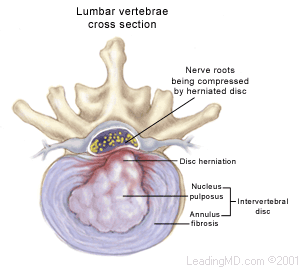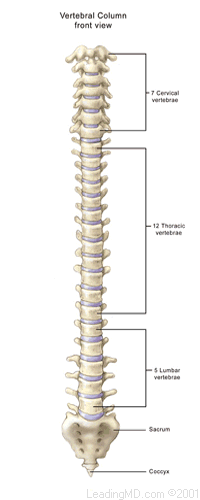






 Discs
are the pads between the vertebrae of the spine. There are twenty-four
mobile vertebrae and five that are fused together to form the
sacrum. Discs are vulnerable to injury because
they have the difficult job of being flexible enough to move,
but strong enough to take enormous stress.
Discs
are the pads between the vertebrae of the spine. There are twenty-four
mobile vertebrae and five that are fused together to form the
sacrum. Discs are vulnerable to injury because
they have the difficult job of being flexible enough to move,
but strong enough to take enormous stress.
The discs between the lower
lumbar vertebrae are the most commonly injured because they
support the weight of the entire upper body. The structure
of the disc determines the extent of injury, if one occurs.
Disc herniation,
rupture, protrusion, and extrusion
are all terms that describe this injury. There are subtle
differences between these terms, but they all refer to a tear
in the outer ring, which allows some of the inner core to
escape. A herniation occurs when a portion of the soft inner
core (nucleus pulposis) escapes through the
outer ring (annulus).
The disc may look like a solid
piece of padding between the vertebrae, but it is far more
complex. Discs are composed of two parts that work together
to carry the load.
- The strong outer ring or
annulus, is firmly attached to the vertebrae above and below
the disc. The ring has strong crosshatched fibers much like
the steel belts of a car tire. This outer ring is about
1/4 inch thick, and by itself, doesn't have much compressive
strength. If this ring were empty, it would collapse when
weight was applied to the bone above. The outer ring holds
the nucleus pulposis in place.
- The nucleus pulposis is located
inside the annulus. This is a soft gelatin-like cartilage
with a very high water content which provides cushioning
while evenly supporting the weight of the body. This cartilage
transmits the load from bone to bone.
There is a delicate balance between
the forces trying to push the gelatin-like nucleus out to the
sides and the tension of the outer ring holding it in place.
The disc has two functions:
- it transmits the weight of
the body from the bone above to the bone below.
- it allows the spine to be
flexible.
The lumbar (lower
back) discs must support the weight of the entire upper body
plus whatever is picked up or carried. Because the body's center
of gravity is in front of the discs, loads on the disc are increased
by leverage, much like a nutcracker multiplies force on a nut.
Research has shown that picking up a 20 pound weight may
increase pressures inside the disc by more than eight times
the body's weight. The job of the disc is to transmit this
load efficiently and evenly to the vertebra below. The gelatin-like
nucleus pulposis distributes the stress evenly across the surfaces
of the adjacent bones. The combination of soft inner core and
strong outer ring also allows maximum motion between the bone
segments. Both of these functions are severely tested in
the lumbar spine, where enormous loads frequently occur and
physical activities demand wide ranges of motion.
 |
What is
a herniated lumbar disc?
The outer ring of the disc
is subject to continuous stresses that sometimes cause
small tears to develop. If one of these tears is large
enough and the stresses inside the disc strong enough,
some of the pulposis can leak through the tear. The disc
is most vulnerable to injury at the weakest parts of the
outer ring, where nerves pass through the spinal canal
and exit toward the legs. If disc material compresses
one of these nerves, there can be pain both in the back
and down the leg . Pain down the leg is often called sciatica,because
the most frequently pinched nerves form the sciatic
nerve, which runs down the back of the thigh to
the lower leg.
A disc can herniate due to
either a sudden load or an accumulation of minor injuries
over time. At least 50% of patients can't recall a specific
event that caused the ruptured disc. When an event can
be identified, it often involved lifting and twisting;
activities that place severe stresses on the disc.
Discs are named for the bones above and below them. For
example, the L4-5 disc is between the 4th and 5th lumbar
bones. The L5-S1 disc is between the 5th lumbar and 1st
sacral bones. These two discs do the most work and
are the most frequently injured. Paralysis rarely occurs
with disc herniation. The spinal cord proper ends
at the first lumbar vertebra (L1), well above these frequently
injured discs.
Other conditions that cause back and leg pain can mimic
a ruptured lumbar disc. Some of these conditions are:
- arthritis of the hip
or knee area.
- pulled muscles in the
back (lumbar strain).
- pulled muscles in the
leg and other conditions that cause irritation of
the spinal nerves.
|

© 2016 by leadingmd.com All rights reserved.
Disclaimer







 Discs
are the pads between the vertebrae of the spine. There are twenty-four
mobile vertebrae and five that are fused together to form the
sacrum. Discs are vulnerable to injury because
they have the difficult job of being flexible enough to move,
but strong enough to take enormous stress.
Discs
are the pads between the vertebrae of the spine. There are twenty-four
mobile vertebrae and five that are fused together to form the
sacrum. Discs are vulnerable to injury because
they have the difficult job of being flexible enough to move,
but strong enough to take enormous stress.